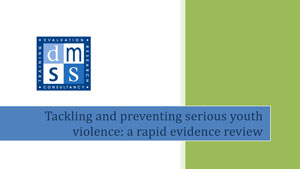Youth violence is rarely out of the news. Every week the headlines report another tragic death or serious injury, often of a young person
and often involving the use of knives by other young people. Understandably there is a call for something to be done. So, what’s the
evidence for effective approaches to reducing youth violence?
We recently completed a review on this topic focusing on community initiatives and looking particularly at the public health
approaches which are becoming increasingly popular. The volume of literature in this field is considerable and it is easy to get bogged down
in all that has been written. However, we conclude that there are some very consistent messages about the key factors that need to be taken
into account to address youth violence, and what is most likely to make the most difference. As the Mayor of London has recently observed,
there is no quick fix to youth crime, but there are things that can make a difference:
- As the causes of youth violence are multiple and multi-layered, responses need to be the same. This means that programmes need to
intervene with individuals, families, schools and whole neighbourhoods/communities. This is what taking a 'public health approach' means.
- Responses to youth violence need to be co-ordinated across agencies to ensure that there are interventions at all levels of prevention,
diversion and law enforcement. Initiatives funded to work at the prevention and diversion levels have more chance of working in areas
where there is also effective policing.
- The young people most vulnerable to involvement in violence are those with a combination of risk factors in their lives. Many of these
can be identified very early – certainly while they are in primary school. Early intervention to ameliorate these risk factors makes sense
and there are some well evidenced programmes supporting parenting, early education and targeted support in the primary years. These should
be used rather than new ones invented.
- For the most at risk teenagers many of the early building blocks of resilience are missing or under-developed. However, it is still
possible to bolster young people’s resilience through supportive relationships with consistent adults and the development of skills and
positive experiences. Therefore, such relationships need to be seen as core to any initiative.
- The lives of children and young people stretch across families, schools and communities. The most effective projects do the same. They
act as a bridge across these areas of life and adapt over time to take account of their changing influence as young people grow up. Projects
which can provide consistent relationships from childhood well into young adulthood are hugely valued by young people.
- Projects need to look for the right windows of opportunity to intervene with young people - their 'reachable moments'. These can be
times of transition (e.g. from primary to secondary school) or at points of particular vulnerability (e.g. when a family member is
imprisoned, a young person is first 'in trouble' or after an assault).
- There is some evidence for the ways of working which are likely to be most effective. Mentoring is one, but the nature and quality of
relationships is key. It is important to find mentors who are attuned to young peoples' lives and are insiders to their communities.
- Diversionary activities are important but they also need to be real for young people i.e. they need to build real skills and be about
shared passions.
- Youth violence affects girls and women as well as boys and men. Many programmes have traditionally targeted the latter or failed to
address gender as a significant issue. Addressing the needs of both young men and women has implications for staffing, the kinds of
activities on offer and the issues that need to be prioritised.
- Concern about gangs is understandable but has been in danger of obscuring the wider causes and potential solutions to youth violence.
Projects need to address the full range of violence and abuse in young people’s lives: violence between young men, abuse in intimate
relationships, sexual violence and exploitation are all part of the overall picture.
- Youth violence is a community issue. There is evidence of the power of communities in both supporting their young people and in giving
clear messages about not tolerating violence. A holistic project would therefore involve community members in both the planning and
implementation of programmes. The learning from asset-based community development suggests that identifying and working with the key
'community connectors' is important, and that these are not necessarily designated community leaders but those who operate quietly behind
the scenes (and are often women).
Read the full review here
<< Back to Blogs

